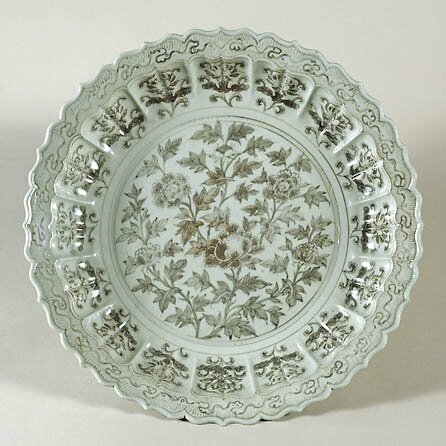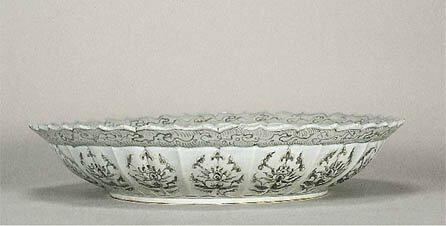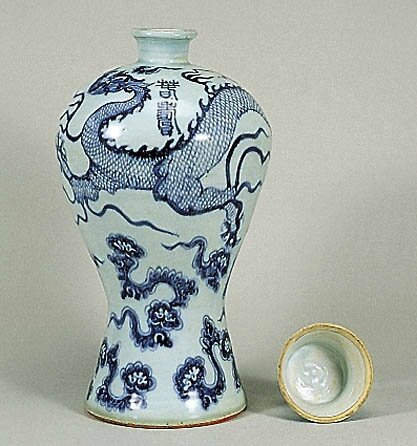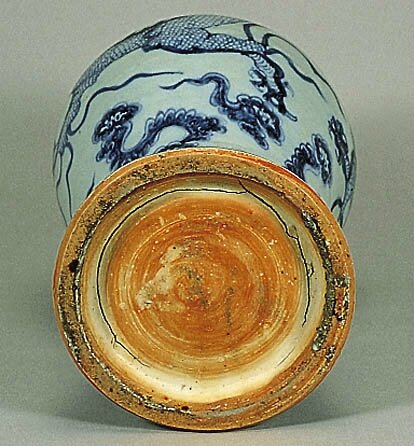Hongwu Period Porcelains at the Museum of Oriental Ceramics, Osaka
Porcelain Charger with Underglaze Copper-Red-Painted Peony Design, Ming Dynasty, Hongwu Period, 1368-1398, d.45.5cm. Acc. No. 10482. Gift of SUMITOMO Group, the ATAKA Collection. The Museum of Oriental Ceramics, Osaka. © 2009 The Museum of Oriental Ceramics, Osaka
The technique of decorating pots with underglaze copper pigment first appeared in the Yuan dynasty. A particularly large amount was produced in the Hongwu period, and the forms and decorative patterns of such ware are similar to those of blue-and-white ware. During this period, private overseas trade was banned, causing a shortage of cobalt pigment. To compensate for this shortage, copper pigment was used instead of cobalt. Copper, however, is unstable as a colorant, and the works fired in this period came out in a variety of colors. Only the peony flowers in the center of this dish are a vivid red, while the baoxiang flowers on the inside and the wave scrolls around the rim are a pale color. Recently, large amount of Hongwu style porcelain shards have been excavated from a site at Zhushan, Jingdezhen city.
Blue-and-White covered meiping with Dragon among Clouds Design, Ming Dynasty, Hongwu Period (1368-1398), h.36.6cm. Gift of Mr. TOHATA Kenzo. Acc. No. 11265. The Museum of Oriental Ceramics, Osaka. © 2009 The Museum of Oriental Ceramics, Osaka.
The form of this vase is what is called meiping, but the shape differs from that found in Yuan blue-and-white wares. The powerfully swelling shoulder slopes sharply down, then flares towards the bottom. The inside of the base is carved out leaving a thick wall. There is a lid with a "sacred jewel" shaped knob that fits over the high mouth of the body. Instead of a decorative band, the design depicts a five-clawed dragon over the upper part of the body, while magic fungus-shaped clouds encircle the lower part. Sherds of plates bearing a cobalt-blue design of magic fungus-shaped clouds have been unearthed at the site of the Hongwu court in Nangjin, confirming that the example shown here may be dated to the Hougwu reign of the early Ming dynasty. The shoulder bears the auspicious characters ''chun shou'' in the so-called seal script style. Similar items are found in the Shanghai Museum and elsewhere.

/https%3A%2F%2Fprofilepics.canalblog.com%2Fprofilepics%2F1%2F0%2F100183.jpg)
/https%3A%2F%2Fstorage.canalblog.com%2F03%2F02%2F119589%2F96711876_o.jpg)
/https%3A%2F%2Fstorage.canalblog.com%2F11%2F31%2F119589%2F94773502_o.jpg)
/https%3A%2F%2Fstorage.canalblog.com%2F20%2F83%2F119589%2F94772815_o.jpg)
/https%3A%2F%2Fstorage.canalblog.com%2F26%2F72%2F119589%2F75604929_o.jpg)
/https%3A%2F%2Fstorage.canalblog.com%2F59%2F60%2F119589%2F26458628_o.jpg)








/http%3A%2F%2Fstorage.canalblog.com%2F76%2F15%2F119589%2F129393400_o.jpg)
/http%3A%2F%2Fstorage.canalblog.com%2F74%2F57%2F119589%2F128709421_o.jpg)
/http%3A%2F%2Fstorage.canalblog.com%2F99%2F76%2F119589%2F126944862_o.jpg)
/http%3A%2F%2Fstorage.canalblog.com%2F97%2F88%2F119589%2F126616983_o.jpg)